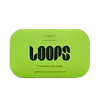What's inside
What's inside
 Key Ingredients
Key Ingredients

 Benefits
Benefits

 Concerns
Concerns

 Ingredients Side-by-side
Ingredients Side-by-side

Water
Skin ConditioningGlycerin
HumectantButylene Glycol
HumectantPentylene Glycol
Skin Conditioning1,2-Hexanediol
Skin ConditioningCeratonia Siliqua Gum
EmollientChondrus Crispus Powder
AbrasiveButyrospermum Parkii Butter
Skin ConditioningHydroxyethyl Urea
HumectantAllantoin
Skin ConditioningCellulose Gum
Emulsion StabilisingGlucomannan
Skin ConditioningXanthan Gum
EmulsifyingPotassium Chloride
Caprylyl Glycol
EmollientSodium Polyacrylate
AbsorbentDextrin
AbsorbentCI 77288
Cosmetic ColorantEthylhexylglycerin
Skin ConditioningCI 77492
Cosmetic ColorantAlpha-Arbutin
AntioxidantMelaleuca Alternifolia Leaf Oil
AntioxidantPrunus Armeniaca Seed Powder
AbrasiveSalix Alba Bark Extract
AstringentTranexamic Acid
AstringentCaprylic/Capric Triglyceride
MaskingHelianthus Annuus Seed Oil
EmollientHydroxypropyl Cyclodextrin
MaskingMorus Alba Root Extract
BleachingPhytic Acid
Centella Asiatica Extract
CleansingGlycyrrhiza Uralensis Root Extract
Skin ConditioningCucurbita Pepo Fruit Extract
Skin ConditioningCarthamus Tinctorius Flower Extract
Skin ConditioningChrysanthellum Indicum Extract
Skin ConditioningLonicera Japonica Flower Extract
Skin ConditioningNelumbo Nucifera Flower Extract
Skin ConditioningCarica Papaya Fruit Extract
Skin ConditioningActinidia Chinensis Fruit Extract
EmollientCitrus Limon Fruit Extract
MaskingGaultheria Procumbens Leaf Extract
PerfumingPyrus Communis Fruit Extract
Skin ConditioningSolanum Lycopersicum Fruit Extract
AntioxidantVitis Vinifera Fruit Extract
Skin ConditioningWater, Glycerin, Butylene Glycol, Pentylene Glycol, 1,2-Hexanediol, Ceratonia Siliqua Gum, Chondrus Crispus Powder, Butyrospermum Parkii Butter, Hydroxyethyl Urea, Allantoin, Cellulose Gum, Glucomannan, Xanthan Gum, Potassium Chloride, Caprylyl Glycol, Sodium Polyacrylate, Dextrin, CI 77288, Ethylhexylglycerin, CI 77492, Alpha-Arbutin, Melaleuca Alternifolia Leaf Oil, Prunus Armeniaca Seed Powder, Salix Alba Bark Extract, Tranexamic Acid, Caprylic/Capric Triglyceride, Helianthus Annuus Seed Oil, Hydroxypropyl Cyclodextrin, Morus Alba Root Extract, Phytic Acid, Centella Asiatica Extract, Glycyrrhiza Uralensis Root Extract, Cucurbita Pepo Fruit Extract, Carthamus Tinctorius Flower Extract, Chrysanthellum Indicum Extract, Lonicera Japonica Flower Extract, Nelumbo Nucifera Flower Extract, Carica Papaya Fruit Extract, Actinidia Chinensis Fruit Extract, Citrus Limon Fruit Extract, Gaultheria Procumbens Leaf Extract, Pyrus Communis Fruit Extract, Solanum Lycopersicum Fruit Extract, Vitis Vinifera Fruit Extract
Water
Skin ConditioningGlycerin
HumectantButylene Glycol
HumectantPropanediol
SolventCeratonia Siliqua Gum
EmollientPolyglycerin-3
HumectantChondrus Crispus Powder
AbrasivePanthenol
Skin ConditioningHydroxyacetophenone
AntioxidantAllantoin
Skin ConditioningBetaine
HumectantXanthan Gum
EmulsifyingChlorphenesin
AntimicrobialHydroxyethyl Urea
HumectantCellulose Gum
Emulsion StabilisingGlucomannan
Skin ConditioningDisodium EDTA
Potassium Chloride
Dextrin
AbsorbentDipotassium Glycyrrhizate
HumectantEthylhexylglycerin
Skin ConditioningAdenosine
Skin ConditioningTocopherol
Antioxidant1,2-Hexanediol
Skin ConditioningHoney Extract
HumectantOryza Sativa Extract
AbsorbentOenothera Biennis Flower Extract
AstringentPinus Palustris Leaf Extract
TonicPueraria Thunbergiana Root Extract
Skin ConditioningUlmus Davidiana Root Extract
Skin ConditioningCI 77491
Cosmetic ColorantWater, Glycerin, Butylene Glycol, Propanediol, Ceratonia Siliqua Gum, Polyglycerin-3, Chondrus Crispus Powder, Panthenol, Hydroxyacetophenone, Allantoin, Betaine, Xanthan Gum, Chlorphenesin, Hydroxyethyl Urea, Cellulose Gum, Glucomannan, Disodium EDTA, Potassium Chloride, Dextrin, Dipotassium Glycyrrhizate, Ethylhexylglycerin, Adenosine, Tocopherol, 1,2-Hexanediol, Honey Extract, Oryza Sativa Extract, Oenothera Biennis Flower Extract, Pinus Palustris Leaf Extract, Pueraria Thunbergiana Root Extract, Ulmus Davidiana Root Extract, CI 77491
Ingredients Explained
These ingredients are found in both products.
Ingredients higher up in an ingredient list are typically present in a larger amount.
1,2-Hexanediol is a synthetic liquid and another multi-functional powerhouse.
It is a:
- Humectant, drawing moisture into the skin
- Emollient, helping to soften skin
- Solvent, dispersing and stabilizing formulas
- Preservative booster, enhancing the antimicrobial activity of other preservatives
Allantoin is a soothing ingredient known for its protective and moisturizingg properties. Because of this, it is often added to products with strong active ingredients.
Studies show higher concentrations of this ingredient can promote wound healing.
Though it can be derived from the comfrey plant, allantoin is produced synthetically for cosmetic products to ensure purity.
Learn more about AllantoinButylene Glycol (or BG) is used within cosmetic products for a few different reasons:
Overall, Butylene Glycol is a safe and well-rounded ingredient that works well with other ingredients.
Though this ingredient works well with most skin types, some people with sensitive skin may experience a reaction such as allergic rashes, closed comedones, or itchiness.
Learn more about Butylene GlycolCellulose Gum is a water-soluble polymer that comes from cellulose. It is used to change the texture of a product and to help stabilize emulsions.
As an emulsifier, cellulose gum specifically thicken the texture of water-based products.
This ingredient is considered hypoallergenic and non-toxic. Cellulose Gum can be found in cosmetics, food, and other household goods such as paper products.
Learn more about Cellulose GumCeratonia Siliqua Gum is extracted from the seeds of the carob tree. You might know this ingredient as Carob Gum or Locust Bean Gum. It is used to stabilize other ingredients and improve the texture of products.
Carob gum is made up of long-chain polysaccharides. This makes it a natural thickener.
Yes! This ingredient comes from the seeds of a tree. The name 'Locust Bean Gum' can be misleading.
Learn more about Ceratonia Siliqua GumChondrus Crispus Powder is an exfoliant.
Dextrin is used to thicken a product and helps bind ingredients together. It is created from starch and glycogen.
As an emulsifier, dextrin prevents ingredients from separating. This helps elongate a product's shelf life.
Studies show coating UV filters with dextrin prevents these ingredients from being absorbed. This helps UV ingredients last longer on the skin.
Learn more about DextrinEthylhexylglycerin (we can't pronounce this either) is commonly used as a preservative and skin softener. It is derived from glyceryl.
You might see Ethylhexylglycerin often paired with other preservatives such as phenoxyethanol. Ethylhexylglycerin has been found to increase the effectiveness of these other preservatives.
Glucomannan is a fiber created from the Konjac plant. It is an emulsifier and thickener.
The high polysaccharide content makes it great at adjusting the texture of products. (Kind of like starch).
Polysaccharides also help our skin stay hydrated.
This ingredient is water-soluble.
Learn more about GlucomannanGlycerin is already naturally found in your skin. It helps moisturize and protect your skin.
A study from 2016 found glycerin to be more effective as a humectant than AHAs and hyaluronic acid.
As a humectant, it helps the skin stay hydrated by pulling moisture to your skin. The low molecular weight of glycerin allows it to pull moisture into the deeper layers of your skin.
Hydrated skin improves your skin barrier; Your skin barrier helps protect against irritants and bacteria.
Glycerin has also been found to have antimicrobial and antiviral properties. Due to these properties, glycerin is often used in wound and burn treatments.
In cosmetics, glycerin is usually derived from plants such as soybean or palm. However, it can also be sourced from animals, such as tallow or animal fat.
This ingredient is organic, colorless, odorless, and non-toxic.
Glycerin is the name for this ingredient in American English. British English uses Glycerol/Glycerine.
Learn more about GlycerinPotassium Chloride can be bad for oily skin and be bad for acne prone skin.
Water. It's the most common cosmetic ingredient of all. You'll usually see it at the top of ingredient lists, meaning that it makes up the largest part of the product.
So why is it so popular? Water most often acts as a solvent - this means that it helps dissolve other ingredients into the formulation.
You'll also recognize water as that liquid we all need to stay alive. If you see this, drink a glass of water. Stay hydrated!
Learn more about WaterXanthan gum is used as a stabilizer and thickener within cosmetic products. It helps give products a sticky, thick feeling - preventing them from being too runny.
On the technical side of things, xanthan gum is a polysaccharide - a combination consisting of multiple sugar molecules bonded together.
Xanthan gum is a pretty common and great ingredient. It is a natural, non-toxic, non-irritating ingredient that is also commonly used in food products.
Learn more about Xanthan Gum